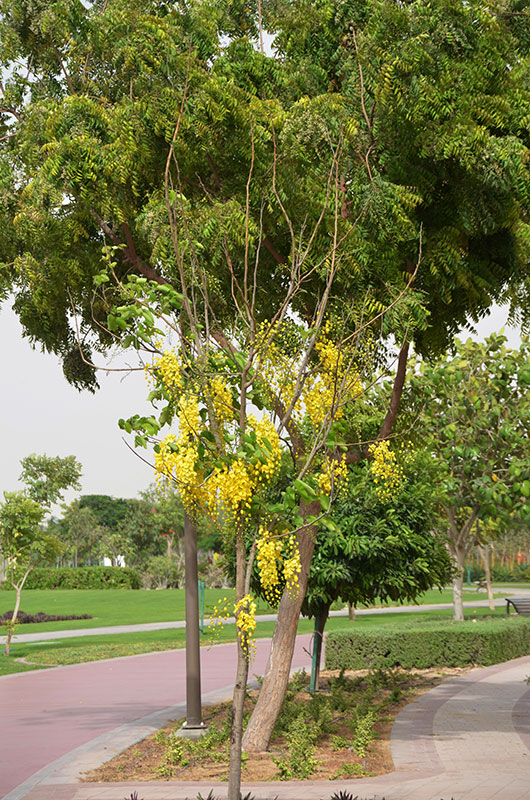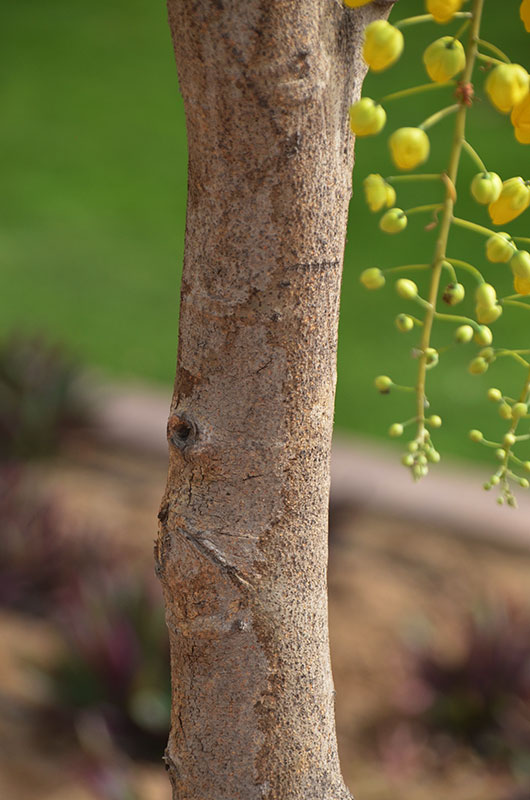
Tropicals, Woody > Cassia > Cassia fistula > Cassia fistula
Cassia fistula
Golden Shower Tree, Indian Laburnum, Purging Fistula, Amaltas, Pudding Pipe Tree, Golden Chain Tree, Lantern Tree (Thailand)
Origin: South-west Pakistan, including Swat and Hazara to 1200 m, India, Myanmar (Burma), Ceylon and nearby regions in Southeast Asia.
Mike's
Opinion


"
Cassia fistula is a beautiful flowering tree with unusual, interesting fruit and significant cultural relevance. In spring, the tree will produce large quantities of showy yellow flowers on hanging racemes, the flowers are excellent for attracting pollinators and butterflies. The fruit of Cassia fistula is a thin, long, brownish-black legume containing pulp and poisonous seeds. It is a very durable plant and not vulnerable to drought or saline soils. It has many uses in the cultured landscape. Medicinal ingredients can be derived from most parts of the tree.
Michael Pascoe, NDP., ODH., CLT., MSc. (Plant Conservation)
"
| Family |
| Fabaceae |
| Genus |
| Cassia |
| Species |
| fistula |
| Category |
| Tropicals, Woody |
| Type |
| Tree (deciduous) |
| USDA Hardiness Zone |
| 9.5 |
| Canadian Hardiness Zone |
| Requires cool season protection under glass |
| RHS Hardiness Zone |
| H2 |
| Temperature (°C) |
| 0 |
| Temperature (°F) |
| 32 |
| Height |
| 10 - 20 m |
| Spread |
| 10 - 20 m |
Photographs
Description and Growing Information
Flowering Period
| General Description |
| Cassia fistula is a flowering tree in the Fabaceae family native to India and Southeast Asia. It is a showy plant with vibrant flowers in the spring and early summer. |
| Landscape |
| Cassia fistula has high ornamental value in tropical areas where it can be used as a specimen, accent, or street planting. Suitable in areas of drought or saline soils and where pollution may be an issue. |
| Cultivation |
| Grown in subtropical and tropical regions, it does best in full sun and well-drained soil. It is drought and salt tolerant, however, it will suffer if exposed to freezing weather, even briefly. |
| Shape |
| This tree has a rounded and somewhat irregular shape. |
| Growth |
| Fast |
| ID Characteristic |
| Medium to large-sized tree with an oval to rounded shape. Distinctive yellow flowers in the spring persisting into the summer which mature into long brown cylindrical legumes that persist into the following spring. |
| Pests |
| Cassia fistula is susceptible to mildew, leaf spot, and root diseases. |
| Habitat |
| Grows in valleys of India and the Himalaya region up to approximately 1200 m. Common in deciduous forests in the region. |
| Bark/Stem Description |
| The bark is smooth to slightly ridged, grey when young, and changing slightly to a darker grey-brown when mature. |
| Leaf Description |
| Pinnately, compound, opposite leaves that are smooth and ovate-shaped, with 6 -16 leaflets. The leaf can range from 15 - 60 cm long, with each leaflet ranging from 7 - 20 cm long. The leaves will fall periodically, only to be replaced with new foliage. However, complete leaf drop occurs during the flowering period in March. |
| Flower Description |
| Large bright yellow flowers grow from pendulous 40 cm racemes. Each flower has five equal-sized petals, and is about 2 - 4 cm in size. |
| Fruit Description |
| Ranging from 30 - 60 cm long and up to 3 cm wide. The terete is glabrous, indehiscent pod is black at maturity. It has a strange pungent smell. While the fruit pulp has medicinal properties, the seeds are poisonous. The pods contain approximately 30 -100 large hard flat, round seeds. |
| Colour Description |
| Cassia fistula tree is well known for its impressive yellow flowers that cover the entire canopy. The flowers mature into brown to purple-black pods. The leaves on this tree are green year round, and remain green until they fall off and are replaced. The bark of the tree is grey-coloured when young, which changes to a darker grey-brown colour as it ages. Flower buds are green when immature. |
| Texture Description |
| Medium texture and very fine flowers. However, the tree has a rather rough-textured bark and plain leaves. |
| Notable Specimens |
| University of Arizona, Nugent Building, Arizona, United States of America. Royal Park Rajapruek, Mae Hia, Thailand. |
| Propagation |
| Care must be taken when handling seeds as they are poisonous. The seeds must be gathered from pods and cleaned thoroughly to remove the pulp. Once cleaned, seeds must be gently scarified and soaked for 24 hours prior to sowing. Seeds can then be planted in well-drained soil in a warm sunny location and watered infrequently. In 1 - 4 weeks, the seedlings will emerge. |
| Ethnobotanical Uses (Disclaimer) |
| Ancient Indian culture used most parts of this plant in several medicines. Pulp from the fruit of Cassia fistula is, however, considered to have the greatest medicinal value. The pulp aids as a digestive and anti-inflammatory agent, but is best known as a very safe and gentle laxative. The root from this tree is also used in the treatment of various skin diseases, while the leaves are used in ointments. Some medicines derived from this plant are still used today. The strongly-scented seed pulp is added to tobacco in India and smoked. The bark in Pakistan is used in tanning, while the wood ash is used as a mordant in dyeing. The wood has many uses in construction. This tree's bloom is the national flower of Thailand, and also the floral emblem of the Indian state of Kerala. In Thailand, the flower of Cassia fistula represents royalty. |
References
Heywood, V. (1978). Flowering Plants of the World. Englewood Cliffs N.J.: Prentice-Hall INC.
Nathaniel Lord Britton, H. A. (1970). An Illustrated Flora of the Northern United States and Canada 2nd. Ed. New York City: Dover Publications.
Staff of theL.H Bailey Hortorium, C. U. Hortus Third, A Concise Dictionary of Plants Cultivated in the United States and Canada. New York City: MacMillan Publishing Co. INC.


